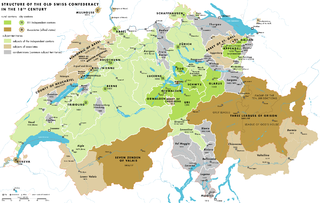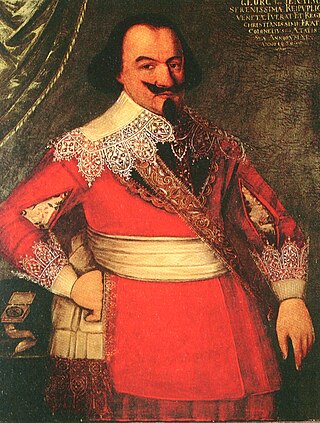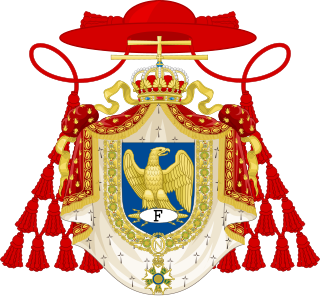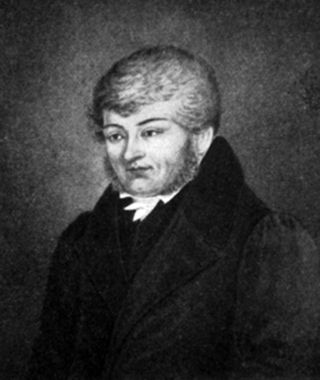Related Research Articles

Basel, also known as Basle, is a city in northwestern Switzerland on the River Rhine. Basel is Switzerland's third-most-populous city, with 177,595 inhabitants within the city municipality limits. The official language of Basel is Swiss Standard German and the main spoken language is the local Basel German dialect.

Political identity came to the territory now occupied by the Principality of Liechtenstein in 814, with the formation of the subcountry of Lower Rhætia. Liechtenstein's borders have remained unchanged since 1434, when the Rhine established the border between the Holy Roman Empire and the Swiss cantons.

Joseph Cardinal Fesch, Prince of the Empire was a French priest and diplomat, who was the maternal half-uncle of Napoleon Bonaparte. In the wake of his nephew, he became Archbishop of Lyon and cardinal. He was also one of the most famous art collectors of his period, remembered for having established the Musée Fesch in Ajaccio, which remains one of the most important Napoleonic collections of art.

The early modern history of the Old Swiss Confederacy and its constituent Thirteen Cantons encompasses the time of the Thirty Years' War (1618–1648) until the French invasion of 1798.

Jörg Jenatsch, also called Jürg or Georg Jenatsch, was a Swiss political leader during the Thirty Years' War, one of the most striking figures in the troubled history of the Grisons in the 17th century.

Johann Konrad Ammann was a Swiss physician and instructor of non-verbal deaf persons.

The Historical Dictionary of Switzerland is an encyclopedia on the history of Switzerland. It aims to present the history of Switzerland in the form of an encyclopaedia, published both on paper and on the internet, in three of the country's national languages: German, French and Italian. When it was completed at the end of 2014, the paper version contained around 36,000 articles divided into thirteen volumes. At the same time, a reduced edition of the dictionary has been published in Romansh under the title Lexicon istoric retic (LIR), and constitutes the first specialist dictionary in the Rhaeto-Romance, Switzerland.

Johann Rudolph Schellenberg was a Swiss artist, writer and entomologist best known for his illustrations of insects.

The Burckhardt family alternatively also (de) Bourcard is a family of the Basel patriciate, descended from Christoph (Stoffel) Burckhardt (1490–1578), a merchant in cloth and silk originally from Münstertal, Black Forest, who received Basel citizenship in 1523, and became a member of the Grand Council of Basel-Stadt in 1553.

Sebastian Peregrin Zwyer was a Swiss military commander, mercenary entrepreneur, and one of the foremost politicians of the Old Swiss Confederacy in the seventeenth century.

Johann Rudolf Wettstein was a Swiss diplomat and mayor of Basel, who achieved fame through his diplomatic skills, culminating in Swiss independence from the Holy Roman Empire in 1648.

Rudolf Koller was a Swiss painter. He is associated with a realist and classicist style, and also with the essentially romantic Düsseldorf school of painting. Koller's style is similar to that of the realist painters Gustave Courbet and Jean-Baptiste-Camille Corot. Considered Switzerland's finest animal painter, Koller is rated alongside George Stubbs, Rosa Bonheur and Théodore Géricault. While his reputation was based on his paintings of animals, he was a sensitive and innovative artist whose well-composed works in the "plein air" tradition, including Swiss mountain landscapes, are just as finely executed.

Friedrich Freiherr (Baron) von Hotze, was a Swiss-born general in the Austrian army during the French Revolutionary Wars. He campaigned in the Rhineland during the War of the First Coalition and in Switzerland in the War of the Second Coalition, notably at Battle of Winterthur in late May 1799, and the First Battle of Zurich in early June 1799. He was killed at the Battle of Linth River.

The Seyler family is a Swiss family, originally a patrician family from Liestal near Basel. Family members served as councillors and Schultheißen of Liestal from the 15th century, later also as members of the Grand Council of Basel. A Hamburg branch descended from the banker and renowned theatre director Abel Seyler became by marriage a part of the Berenberg banking dynasty, co-owners of Berenberg Bank and part of Hamburg's ruling class of Hanseaten.
The Amerbach Cabinet was a collection of artifacts, paintings, libraries, assembled by members of the Amerbach family, most notably by the two law professors of the University of Basel, Bonifacius Amerbach and his son Basilius Amerbach the Younger.

The Faesch family, also spelled Fesch, is a prominent Swiss, French, Belgian, Corsican and Italian noble family, originally a patrician family of Basel. Known since the early 15th century, the family received a confirmation of nobility from the Holy Roman Emperor in 1563. It was continuously represented in the governing bodies of the city-republic of Basel for centuries, and three members served as Burgomasters, i.e. heads of state, namely Remigius Faesch (1541–1610), Johann Rudolf Faesch (1572–1659) and Johann Rudolf Faesch (1680–1762). The family was at times the richest family of Basel, and its rise was partially the result of clever marriage policies.
Hans Buser, also known as Hans von Buus, was Freiherr of the Amt of Liestal from 1536 until his death in 1544.

Johannes Jacob Hegetschweiler was a Swiss physician and botanist. He is remembered for his investigations of Alpine vegetation.
Johann Müller-Rutz was a Swiss entomologist who specialised in the study of microlepidoptera, small moths. He trained as an embroidery artist and worked in first in Müllheim (1885-1888) and then in St. Gallen where he was teacher of embroidery designs at the Industrial and Trade Centre St. Gallen.

Remigius Faesch. was a Swiss jurist and rector of the University of Basel.
References
- ↑ Faesch, Johann Rudolf, in Historisches Lexikon der Schweiz
- ↑ Faesch, Remigius, in Historisches Lexikon der Schweiz